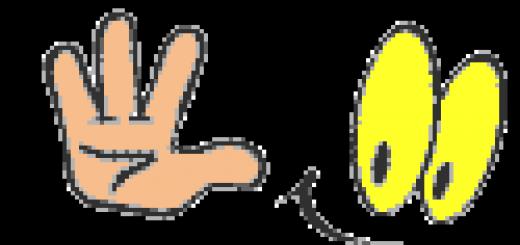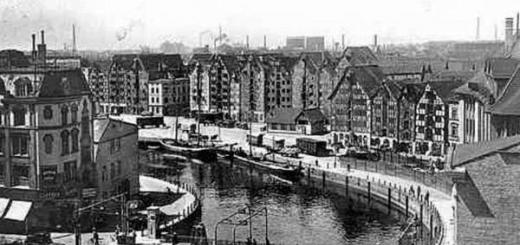Date added: 2013-01-11;
This is the second lesson on the alphabet and the rules for reading the letters of the English language. In this lesson, I will tell you about the next four consonants.
The lesson, like the previous one, will not be long, but I strongly recommend paying attention to the intricacies of reading the letter "hh" and the rules for reading the letter " Gg".
Letter gg
gg[ʤi:] is the seventh letter of the English alphabet. Has two basic reading rules.
1. According to the basic rule of reading, it is no different from Russian "G".
This rule is valid if:
I. Letter gg comes before vowels Aa, oo, uu ;
gas- - gas; petrol
gold- - gold
Gun- - gun (any firearm)
II. Letter gg stands before (any) consonant letter;
green- - green
III. Letter gg stands at the end of a word;
big- - big
2. Before vowels ee , II, Yy reads like "J" .
If taken globally, then the original of this sound is softer than the combination "J". But because of this, there is no particular point in worrying. This option will also work temporarily.
Page- - page
Giant- ["ʤaiənt]- giant
Gymnastics- [ʤim"næstiks]- gymnastics
BUT: In words of French origin, the letter gg can be read as "AND"
Garage- ["gærɑ:ʓ]- garage
3. At the beginning and end of words in a letter combination gn letter gg drops out.
Gnaw- - gnaw
sign- - symbol; signature
4. letter combination gh.
Be careful! This letter combination can produce a sound [g] or sound [f] , and may even be dumb (unreadable). Therefore, to be sure of the correct pronunciation with such a combination of letters, check the words with a dictionary.
ghost- - ghost
high- - high
Laugh- - laugh
Letter hh
hh is the eighth letter of the English alphabet.
Firstly: I can confidently say that you will not see it before the consonant (excluding abbreviations)
Secondly: this letter is read only if it is followed by a vowel. In all other cases, she is silent.
Thirdly: Letter combinations sh, ch, ph, th, gh create extraneous sounds. Two of them are already known to us. (digraph ch and letter combination gh) . The rest we will look at as we study the corresponding letters.
1. Always read as [h]. This sound has no Russian analogue. Many, making a gross mistake, replace this sound with a Russian sound. X.
The sound [h] is an exhalation. A free sound that comes from the chest without encountering any obstacles, unlike X.
house- - house
2. In combination wh + o letter www drops out.
Who- - who
In other cases, in such a letter combination, a letter drops out hh .
when- - when
Letter jj
jj[ʤei] is the tenth letter of the English alphabet.
1. Always read as [ ʤ ], which can be equated to the Russian "J".
jump- [ʤʌmp]- jump
Greetings, my dear readers.
Today we continue to talk about how to learn how to read correctly, so the topic of today's article is the transcription of English letters.
We have already got acquainted with the concept and dealt with the pronunciation of sounds in English. Today we will figure out exactly how they are pronounced in various combinations.
I have a clear table for you. It contains the letters of the English alphabet with transcription, Russian analogue letters and my notes, so that you can immediately put the correct pronunciation. I also added examples of words with studied sounds and their translation.
What else can be found on the blog:
- with letters and transcription (you can study them online, download, print and work with them);
- for children I have a complete .
Let `s start?
Features of English transcription:
- it is always enclosed in square brackets. I can't say exactly where it came from, but I think it's just worth taking it for granted;
- to understand where the stress is, the transcription uses the sign [‘] before the stressed syllable;
- It is important to remember that transcription is about the sound, not the spelling of words. Sometimes the spelling can be 90% different from what we pronounce;
- to show that the sound is long - we use a colon.
In general, I wrote about English transcription - please!
Letters of the English alphabet and their transcription in Russian and English:
| English letter | Transcription | Russian analogue |
| aa | Hey | |
| bb | Bee | |
| CC | Xi | |
| Dd | Di | |
| ee | And | |
| FF | [ɛf] | ef |
| gg | Gee | |
| hh | h | |
| II | Ai | |
| jj | Jay | |
| Kk | Kay | |
| Ll | [ɛl] | Al |
| mm | [ɛm] | Em |
| Nn | [ɛn] | En |
| Oh | [əʊ] | OU |
| pp | Pi | |
| Q | ||
| Rr | [ɑː] or [ɑɹ] | A or Ar |
| Ss | [ɛs] | Es |
| Tt | Tee | |
| Uu | YU | |
| vv | In and | |
| www | [ˈdʌb(ə)l juː] | Double-u |
| xx | [ɛks] | The ex |
| Yy | Wye | |
| Zz | , | Zed, zee |
But you know what is the most interesting thing about English?
If different letters are combined, they are pronounced differently!
That's why I prepared for you
Examples of English letter combinations in Russian and English:
| Combination | Transcription | How to pronounce | Example |
| ee | /i:/ | And | bee - bee |
| ea | / ı:/ | And | tea - tea |
| oo | /u/ | At | cook - cook |
| th | / ð / / Ѳ / | Z, S (interdental) | thumb - finger |
| sh | / ʃ / | W | shout - shout |
| ch | /tʃ/ | H | chair - chair |
| ph | /f/ | F | phone - phone |
| ck | /k/ | To | snack - snack |
| ng | / Ƞ / | Ng | song |
| wh | /w/ | Ua | why - why |
| wr | /r/ | R | write - write |
| qu | /kw/ | Kua | queen - queen |
| igh | /aı/ | Ai | high - high |
| all | /Ɔ:l/ | Ol | tall - tall |
| ai | /eı/ | Hey | Spain |
| ay | /eı/ | Hey | May |
| oi | /oı/ | Ouch | point |
| oy | /oı/ | Ouch | toy |
| ow | /oƱ/ | OU | grow - grow |
| ou | /aƱ/ | ay | out - outside |
| ew | /ju:/ | YU | knew - knew |
| aw | / Ɔ: / | Ltd | draw - draw |
| ee+r | / ıə / | ia | engineer - engineer |
| ou+r | /abə/ | Aue | our - our |
| oo+r | / Ɔ: / | Ltd | door - door |
| wo+r | / ɜ: / | Y/O | work - work |
| ai+r | /eə/ | Ea | chair - chair |
| oa+r | / Ɔ: / | Oo | roar - cry |
| old | /Ʊd/ | Oud | could - could |
| around | /aƱnd/ | Aund | round - round |
| eigh | /eı/ | Hey | eight - eight |
| -y | / ı / | And | tiny - tiny |
| au | / Ɔ: / | Oo | Paul |
| gh | /f/ | F | laugh - laugh |
| aught | /Ɔ:t/ | From | taught - taught |
I know this table looks huge now. Surely you think that remembering all this is unrealistic. I'll tell you this: at a certain point, when you have enough, you won't even pay attention to these combinations. Your brain will learn to quickly remember how these letters sound. Moreover, even when you come across a completely unfamiliar word, you can read it correctly. The only question is the amount of practice on your part.
How to memorize combinations of letters?
- Use cards. Visual perception is better developed in most people.
- Read. Pay attention to letter combinations when or just texts.
- Don't get hung up. It is not necessary to immediately memorize these combinations and only then go directly to English. Learn as you go!
- Buy paper or download a good e-book in order to quickly learn to recognize combinations and pronounce them correctly. Even if you need it - an adult - do not hesitate to take books for children - it is there that everything is chewed in detail and not without interest.
That's all, my dears. I hope you found it useful and understandable. I give even more such materials in the blog mailing list - subscribe and receive a portion of usefulness regularly.
put a widget on Yandex for memorizing the English alphabetDear reader, if before learning English you got acquainted with the names of Latin letters in chemistry or physics ( H 2 O - "ASH-Two-O", mv 2 /2 - "EM-VE Square in Half") or at least when playing chess ( e2-e4 - "E Two - E Four"), then the transcription of English letters may have become an unpleasant surprise for you.
Out of habit, such names of English letters as A - "hey", E - "and", I - "ay" and R - "a"(in the latter case the sound " R"although it is implied, it is very often not pronounced or pronounced very quietly). And the Latin letter W, which in Russian is traditionally called " double-ve", in English called " double", that is " double U", although its bottom edge in the printed image has two sharp, not rounded protrusions. This was because in the old days U and V did not differ. And there are also differences between American, British and Scottish English, between official speech and colloquial.
And still not to be confused with G - "ji", J - "jay" and H - "h", and explain to especially gifted telephone interlocutors that "pi"- this is P, not a Greek letter π (the ratio of the circumference of a circle to its diameter ( ≈3,14 ), while π pronounce in english "share".
Perfect automatic knowledge of the names of English letters is a very important skill that should not be neglected when learning English. Why is this necessary, isn't it better to work out with grammar or expand your vocabulary? But the pronunciation of letters is not theoretical phonetics divorced from life. The fact is that English abbreviations are almost always spelled, and you may also be asked to spell your name or some letter code ( "Could you spell your name, please?" ).
And if you do not know the names of the letters, then you will have to blush and mumble something unintelligible. And some English abbreviations entered the Russian language with incorrect pronunciation, for example VIP should be pronounced like "wee-ah-pee", but already rooted in Russian as "VIP". When abbreviations have several identical letters in a row, they are often pronounced using the words "double-" ("double") and triple- ("triple"), for example, when you need to give an address on the Internet, www pronounced "triple double-u".
But what if you need to pronounce some letter code in radio traffic in the airspace, or at sea? It is impossible to allow misunderstandings and hitches in the negotiations between pilots and the air traffic controller, or in negotiations between the English-speaking military and their non-English-speaking allies, so that the artilleryman does not mix up the code for the square "i" how "e".
To avoid ambiguity or misunderstanding, a code is used to represent letters with words, known as "NATO code"(phonetic alphabet of the International Civil Aviation Organization ICAO). Surprisingly, even this code has flaws in certain situations, which is why in some cases the names of the letters in it had to be replaced.
And if you want the English alphabet with transcription to unobtrusively scroll before your eyes every time you go to Yandex, then you can install a Yandex widget for yourself that will scroll the letters of the alphabet forward, backward or randomly.
It is the most common today. It is spoken in all countries, especially in those frequently visited by tourists. Wherever you go, in any corner of the Earth, you can easily find a person who, speaking in English, can show you how to get somewhere and even give some good advice regarding local rules and regulations.
For this reason, the study of this subject begins at school. From the first grade, a small person is preparing for adulthood, and thanks to language lessons - for communication - free and interesting, without any barriers, the main of which, of course, is language.
How does one start learning a language? Of course, from his alphabet. One of the most curious representatives of the English alphabet is the letter "h". She is eighth in order. And what is remarkable, the sound of this letter is similar to the surrounding "ji" and "jay".
In order to have a complete understanding of it, you need to know the following:
- How is the letter "h" spelled?
- How to pronounce it(in itself and, of course, in words).
Unlike the Russian language, some names have one thing, but in words they are read completely differently. Here, for example, the letter "G". When reading, its seventh letter is pronounced like "ji". However, in the words “give” (give), “garden” (garden), it is read exactly like the Russian “g”.
The letter ech - how do you spell it?
The sound of this letter is similar to the Russian "x". In terms of its spelling, the capital “eych” is identical to the Russian “en”: both letters are written like “Н”, in exactly the same way. Lowercase, on the other hand, looks like an uppercase "pe", but with an elongated "tail" (the English "h" really looks like "p").
The writing of this letter begins with the end of the "tail":
- First, they put a full stop, as if they were going to write "p".
- instead, a loop is written out (the line starts moving to the right and, leaving a rounded trace at the top of the line, descends to its very bottom so that the starting point, together with a short segment, remain on the left side);
- the last stage is the writing of the familiar Russian "p".
The process as a whole is quite simple. At first, of course, you can get confused in all the "loops" and transitions to native letters. But - a little practice, and even an awkward first grader will quickly cope with "h", confidently writing it out.
Read also

How to pronounce the letter h
 The letter "h" is one of the consonants of the English language. It is precisely in sound that it corresponds to the Russian “x”, with the difference that its sound is lighter, airy (it is classified as a deaf consonant).
The letter "h" is one of the consonants of the English language. It is precisely in sound that it corresponds to the Russian “x”, with the difference that its sound is lighter, airy (it is classified as a deaf consonant).
There are specific rules that explain when and where the sound “h” occurs, as well as what kind of pronunciation is correct.
- This letter is written exclusively before vowels.. The tongue should be in the same position as at rest. Lips - somewhat open, relaxed, but not too wide open.
- The desired sound is formed in the gap between the vocal cords. The air, passing from the lungs outward, creates friction and gives out the same sound, similar to "x". The ligaments, however, do not vibrate.
- It must be taken into account that the Russian analogue of the sound of the letter "h" is unnecessarily noisy. In order not to make a gross mistake when pronouncing an English word, you need to relax the top of the throat, and make the air push aspirate and less intense.
- The exception is the letter "eych", located between two vowels. In this case, its sound will be more sonorous, expressive.
Learn more about what dash, colon, parentheses, and other symbols mean.
You can see another version of the English transcription and, if necessary, print or copy for editing in Microsoft Word
English transcription
Pronunciation of English sounds.
Pronunciation of English vowels.
The pronunciation of English sounds is represented by Russian letters, you should understand that it is not possible to convey the correct English pronunciation using the Russian alphabet.
- ɑː long, deep a
- ʌ short vowel a, as in the Russian word to run.
- ɒ = ɔ - short, open about
- ɔː - long o
- зː - long vowel ё, as in the Russian word hedgehog.
- æ - open e
- e - like e in the word these
- ə - unclear unstressed sound, similar to e
- iː - long and
- ɪ - short, open and
- ʊ \u003d u - short u, pronounced with a slight rounding of the lips.
- uː - long y pronounced without much rounding of the lips.
Two-vowel sounds
Pronunciation of English consonants.
- p - p
- b - b
- m - m
- f - f
- v - in
- s - with
- z - z
- t - resembles a Russian sound tpronounced with the tongue positioned at the gums.
- d - resembles a Russian sound dpronounced with the tongue positioned at the gums.
- n - resembles a Russian sound npronounced with the tongue positioned at the gums.
- l - resembles a Russian sound l, pronounced with the tongue positioned at the gums.
- r is a very hard sound pronounced without vibration of the tongue. Corresponds to the sound p in the word lot
- ʃ - soft Russian sh
- ʒ - soft Russian zh, as in the word yeast.
- tʃ- h
- ʤ - similar to the Russian sound j (voiced h)
- k - k
- h - breath, reminiscent of a weakly pronounced sound x
- ju - long yu in the word southern
- je - the sound e in the word spruce
- jɔ - sound ё in the word Christmas tree
- jʌ - sound i in the word pit
- j - resembles the Russian sound й before vowels. Occurs in combination with vowels.
English consonants that do not have approximate equivalents in Russianː
- w - formed with rounded lips (as in a whistle). It looks like a sound delivered with only lips. In translation, it is denoted by letters in or y ː W illiams - Williams, Williams.
- ƞ - Open your mouth and say n without closing your mouth.
- ɵ - Move the slightly flattened tip of the tongue between the teeth and pronounce Russian with
- ð - Push the slightly flattened tip of the tongue between the teeth and say Russian










